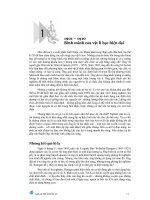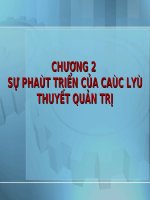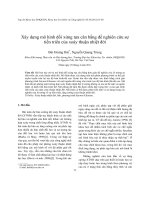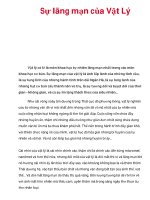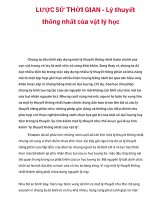SỰ TIẾN TRIỂN CỦA VẬT LÝ HỌC (Anh ngữ)
Bạn đang xem bản rút gọn của tài liệu. Xem và tải ngay bản đầy đủ của tài liệu tại đây (10.32 MB, 347 trang )
TEXT FLY WITHIN
THE BOOK ONLY
OU_160736>5
THE
EVOLUTION OF PHYSICS
THE EVOLUTION OF PHYSICS
BY
A.
EINSTEIN AND
first
L.
INFELD
appeared in
THE CAMBRIDGE LIBRARY
OF MODERN SCIENCE,
a series of new books describing, in
language suitable for the general nonspecialist reader, the present position
in many branches of modern science.
The
series is edited
and
is
by Dr C.
P.
Snow,
published by
CAMBRIDGE UNIVERSITY PRESS
BENTLEY HOUSE, EUSTON ROAD
LONDON, N.W.
I
THE EVOLUTION OF
PHYSICS
BY
ALBERT EINSTEIN
&
LEOPOLD INFELD
THE SCIENTIFIC BOOK CLUB
in CHARING CROSS ROAD
LONDON W.C. *
PREFACE
BEFORE you
begin reading, you rightly expect some
simple questions to be answered. For what purpose has
this book been written? Who is the imaginary reader
for
whom
it is
meant?
begin by answering these questions
and
clearly
convincingly. This would be much easier,
though quite superfluous, at the end of the book. We
find it simpler to say just what this book does not
It is difficult to
We
have not written a textbook of
no
physics.
systematic course in elementary
Our intention was rather
facts
theories.
and
physical
to sketch in broad outline the attempts of the human
mind to find a connection between the world of ideas
and the world of phenomena. We have tried to show
the active forces which compel science to invent ideas
corresponding to the reality of our world. But our
representation had to be simple. Through the maze of
facts and concepts we had to choose some highway
which seemed to us most characteristic and significant.
Facts and theories not reached by this road had to be
omitted. We were forced, by our general aim, to make
a definite choice of facts and ideas. The importance of a
probletn should not be judged by the number of pages
devoted to it. Some essential lines of thought have been
left out, not because they seemed to us unimportant,
but because they do not lie along the road we have
intend to be.
Here
chosen.
is
PREFACE
VI
Whilst writing the book we had long discussions as to
the characteristics of our idealized reader and worried
a good deal about him. We had him making up for a
complete lack of any concrete knowledge of physics
and mathematics by quite a great number of virtues.
We found him interested in physical and philosophical
ideas and we were forced to admire the patience with
which he struggled through the less interesting and
more difficult passages. He realized that in order to
understand any page he must have read the preceding
ones carefully. He knew that a scientific book, even
though popular, must not be read in the same way as
a novel.
The book
is
a simple chat between you and
us.
You
may
boring or interesting, dull or exciting, but
our aim will be accomplished if these pages give you
some idea of the eternal struggle of the inventive
find
it
human mind
for a fuller
understanding of the laws
governing physical phenomena.
A. E.
L.
I.
ACKNOWLEDGMENTS
WE
WISH to thank all those who have so kindly helped
us with the preparation of this book, in particular
:
Professors A. G. Shenstone, Princeton, N.J.,
Loria,
I.
Lwow,
Poland, for
N. Steinberg for
Dr M.
photographs on plate
and St
III.
his drawings.
Phillips for reading the
manuscript and for
her very kind help.
A. E.
L.
I.
CONTENTS
I.
The
The
THE RISE OF THE MECHANICAL VIEW
great mystery story
clue
page 3
first
5
Vectors
12
The
riddle of motion
19
One
clue remains
34
heat a substance?
38
47
Is
The switchback
The rate of exchange
The philosophical background
The kinetic theory of matter
II.
51
55
59
THE DECLINE OF THE MECHANICAL VIEW
The two electric fluids
The magnetic fluids
The first serious difficulty
The velocity of light
71
83
87
94
Light as substance
The riddle of colour
97
100
What is a wave?
The wave theory
104
of light
Longitudinal or transverse light waves?
Ether and the mechanical view
III.
no
120
123
FIELD, RELATIVITY
The field as representation
The two pillars of the field theory
1
29
142
CONTENTS
X
The
reality of the field
Field
page 148
and ether
The mechanical
156
160
scaffold
Ether and motion
172
186
Time, distance, relativity
Relativity and mechanics
The time-space continuum
General
202
209
220
relativity
Outside and inside the
226
lift
Geometry and experiment
General relativity and its verification
Field and matter
IV.
235
249
255
QUANTA
263
Continuity, discontinuity
Elementary quanta of matter and electricity
The quanta of light
265
272
280
Light spectra
The waves of matter
286
Probability waves
Physics
and
294
310
reality
Index
3i7
LIST OF PLATES
Plate
i.
n.
in.
Brownian movement
facing
PaSe 66
Diffraction of light
118
Spectral lines, diffraction of X-rays and of
electronic
waves
286
THE RISE
OF THE MECHANICAL VIEW
I.
THE RISE
OF THE MECHANICAL VIEW
The great mystery story The fast clue Vectors The riddle
The
of motion One clue remains Is heat a substance?
switchback
The rate of exchange The philosophical background The kinetic theory of matter
THE GREAT MYSTERY STORY
IN IMAGINATION there
Such a story presents
exists the perfect
mystery story.
the essential clues, and comus
to
form
our
own
pels
theory of the case. If we
follow the plot carefully, we arrive at the complete
all
solution for ourselves just before the author's disclosure
at the end of the book. The solution itself, contrary to
those of inferior mysteries, does not disappoint us; moreover, it appears at the very moment we expect it.
Can we liken the reader of such a book to the scientists,
who throughout successive generations continue to seek
solutions of the mysteries in the book of nature? The
comparison is false and will have to be abandoned later,
but it has a modicum of justification which may be
extended and modified to make it more appropriate to
the endeavour of science to solve the mystery of the
universe.
This great mystery story
is still
unsolved.
We
cannot
THE EVOLUTION OF PHYSICS
4
even be sure that it has a final solution. The reading
has already given us much; it has taught us the rudiments of the language of nature; it has enabled us to
understand many of the clues, and has been a source
of joy and excitement in the oftentimes painful ad-
vance of science. But we realize that in spite of all the
volumes read and understood we are still far from a
complete solution, if, indeed, such a thing exists at all.
At every stage we try to find an explanation consistent
with the clues already discovered. Tentatively accepted
theories have explained many of the facts, but no
general solution compatible with all known clues has
yet been evolved. Very often a seemingly perfect theory
has proved inadequate in the light of further reading.
New
appear, contradicting the theory or unexplained by it. The more we read, the more fully do we
appreciate the perfect construction of the book, even
facts
though a complete solution seems
to recede as
we
ad-
vance.
In nearly every detective novel since the admirable
of Conan Doyle there comes a time when the
stories
investigator has collected all the facts he needs for at
least some phase of his problem. These facts often seem
and wholly unrelated. The
great detective, however, realizes that no further investigation is needed at the moment, and that only pure
quite strange, incoherent,
thinking will lead to a correlation of the facts collected.
So he plays his violin, or lounges in his armchair en-
joying a pipe, when suddenly, by Jove, he has it Not
only does he have an explanation for the clues at hand,
!
THE RISE OF THE MECHANICAL VIEW
5
but he knows that certain other events must have
happened. Since he now knows exactly where to look
for it, he may go out, if he likes, to collect further confirmation for his theory.
The scientist reading the book of nature, if we may
be allowed to repeat the trite phrase, must find the
solution for himself; for he cannot, as impatient readers
of other stories often do, turn to the end of the book.
In our case the reader is also the investigator, seeking
to explain, at least in part, the relation of events to
their rich context. To obtain even a partial solution the
scientist must collect the unordered facts available and
make them coherent and understandable by
creative
thought.
It
is
our aim, in the following pages,
broad outline that work of
physicists
to describe in
which corre-
sponds to the pure thinking of the investigator. We
shall be chiefly concerned with the role of
thoughts
and ideas in the adventurous search for knowledge of
the physical world.
THE FIRST GLUE
read the great mystery story are as old as
thought itself. Only a little over three hundred
Attempts
human
to
years ago, however, did scientists begin to understand
the language of the story. Since that time, the
of
age
Galileo
and Newton, the reading has proceeded rapidly.
Techniques of investigation, systematic methods of finding and following clues, have been developed. Some of
THE EVOLUTION OF PHYSICS
O
the riddles of nature have been solved, although many
of the solutions have proved temporary and superficial
in the light of further research.
A
most fundamental problem, for thousands of years
wholly obscured by its complications, is that of motion.
All those motions we observe in nature
that of a
stone thrown into the air, a ship sailing the sea, a cart
pushed along the street are in reality very intricate.
understand these phenomena it is wise to begin
with the simplest possible cases, and proceed gradually
to the more complicated ones. Consider a body at rest,
where there is no motion at all. To change the position
of such a body it is necessary to exert some influence
upon it, to push it or lift it, or let other bodies, such as
horses or steam engines, act upon it. Our intuitive idea
is that motion is connected with the acts of pushing,
lifting or pulling. Repeated experience would make us
risk the further statement that we must push harder if
we wish to move the body faster. It seems natural to
conclude that the stronger the action exerted on a body,
the greater will be its speed. A four-horse carriage
goes faster than a carriage drawn by only two horses.
Intuition thus tells us that speed is essentially connected
To
with action.
It is
a familiar fact to readers of detective
fiction
and postpones the
solution. The method of reasoning dictated by intuition was wrong and led to false ideas of motion which
were held for centuries. Aristotle's great authority
throughout Europe was perhaps the chief reason for
that a false clue muddles the story
THE RISE OF THE MECHANICAL VIEW
^
the long belief in this intuitive idea. We read in the
Mechanics , for two thousand years attributed to him:
The moving body comes to a standstill when the
which pushes it along can no longer so act as to push
force
it.
The discovery and use of scientific reasoning by
Galileo was one of the most important achievements
human
thought, and marks the real
beginning of physics. This discovery taught us that
intuitive conclusions based on immediate observation
in the history of
are not always to be trusted, for they sometimes lead
to the wrong clues.
But where does intuition go wrong? Can it possibly
be wrong to say that a carriage drawn by four horses
must travel faster than one drawn by only two?
Let us examine the fundamental
facts
of motion
more
closely, starting with simple everyday experiences
familiar to mankind since the beginning of civilization
and gained
hard struggle for existence.
someone going along a level road with
in the
Suppose that
a pushcart suddenly stops pushing. The cart will go
on moving for a short distance before coming to rest.
We
ask:
how
is
it
possible to increase this distance?
There are various ways, such as oiling the wheels, and
making the road very smooth. The more easily the
wheels turn, and the smoother the road, the longer the
cart will go on moving. And just what has been done
by the oiling and smoothing? Only this: the external
influences have been made smaller. The effect of what
is called friction has been diminished, both in the
wheels and between the wheels and the road. This is
THE EVOLUTION OF PHYSICS
8
already a theoretical interpretation of the observable
evidence, an interpretation which is, in fact, arbitrary.
One significant step farther and we shall have the right
clue. Imagine a road perfectly smooth, and wheels
with no friction at all. Then there would be nothing
to stop the cart, so that it would run for ever. This
is reached only by thinking of an idealized
experiment, which can never be actually performed,
since it is impossible to eliminate all external influences.
conclusion
The
idealized experiment shows the clue which really
formed the foundation of the mechanics of motion.
Comparing the two methods of approaching the
problem, we can say: the intuitive idea is the greater
the action, the greater the velocity. Thus the velocity
shows whether or not external forces are acting on
a body. The new clue found by Galileo is if a body
is neither
pushed, pulled, nor acted on in any other
more
briefly, if no external forces act on a
way, or,
:
body,
it
moves uniformly, that
is,
always with the
same
velocity along a straight line. Thus, the velocity
does not show whether or not external forces are act-
ing on a body. Galileo's conclusion, the correct one,
was formulated a generation later by Newton as the
law of inertia. It is usually the first thing about physics
which we learn by heart in
remember
it
school,
and some of us may
:
Every body perseveres in its state of rest, or of uniform
motion in a right line, unless it is compelled to change that
state by forces impressed thereon.
We
have seen that
this
law of
inertia
cannot be
THE RISE OF THE MECHANICAL VIEW
9
derived directly from experiment, but only by speculative thinking consistent with observation. The idealized
experiment can never be actually performed, although
leads to a profound understanding of real experi-
it
ments.
From
the variety of complex motions in the world
around us we choose
tion.
This
is
as
our
first
example uniform mo-
the simplest, because there are no external
Uniform motion can, however, never be
a stone thrown from a tower, a cart pushed
forces acting.
realized;
along a road can never move absolutely uniformly because we cannot eliminate the influence of external
forces.
In a good mystery story the most obvious clues
wrong suspects. In our attempts to
often lead to the
understand the laws of nature we
find, similarly, that
the most obvious intuitive explanation
wrong one.
Human
often the
thought creates an ever-changing picture of
the universe.
intuitive
is
Galileo's contribution
view and replace
it
by a
was
new
to destroy the
one. This is the
significance of Galileo's discovery.
But a further question concerning motion arises immediately. If the velocity is no indication of the external forces acting on a body, what is? The answer to
this fundamental question was found by Galileo and
still more concisely by Newton, and forms a further
clue in our investigation.
To find the correct answer
more deeply about the
cart
we must
on a
think a
little
perfectly smooth road.

